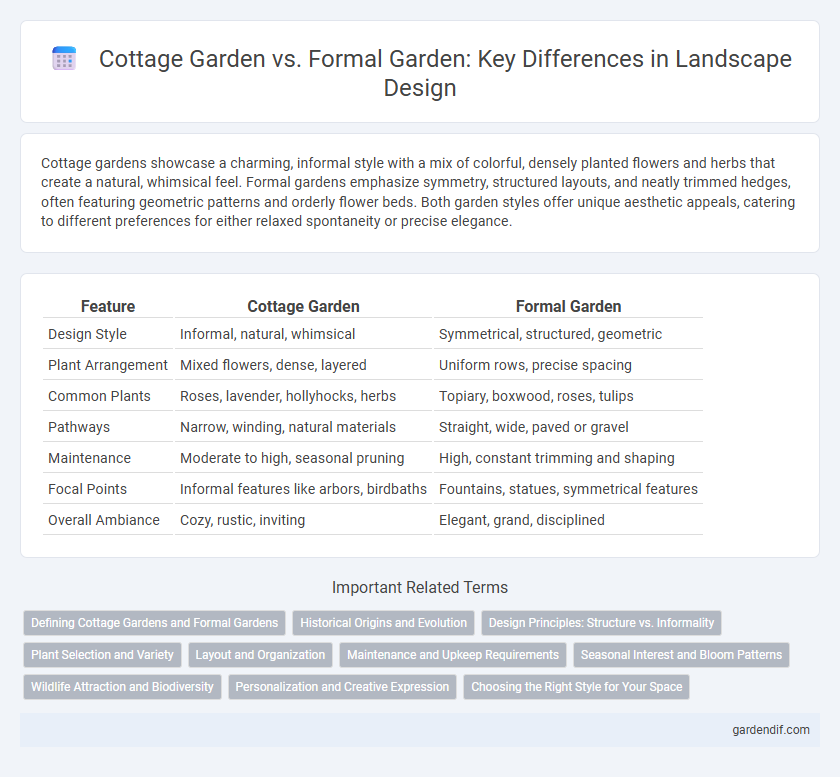
Cottage Garden vs Formal Garden Illustration
Cottage gardens showcase a charming, informal style with a mix of colorful, densely planted flowers and herbs that create a natural, whimsical feel. Formal gardens emphasize symmetry, structured layouts, and neatly trimmed hedges, often featuring geometric patterns and orderly flower beds. Both garden styles offer unique aesthetic appeals, catering to different preferences for either relaxed spontaneity or precise elegance.
Table of Comparison
| Feature | Cottage Garden | Formal Garden |
|---|---|---|
| Design Style | Informal, natural, whimsical | Symmetrical, structured, geometric |
| Plant Arrangement | Mixed flowers, dense, layered | Uniform rows, precise spacing |
| Common Plants | Roses, lavender, hollyhocks, herbs | Topiary, boxwood, roses, tulips |
| Pathways | Narrow, winding, natural materials | Straight, wide, paved or gravel |
| Maintenance | Moderate to high, seasonal pruning | High, constant trimming and shaping |
| Focal Points | Informal features like arbors, birdbaths | Fountains, statues, symmetrical features |
| Overall Ambiance | Cozy, rustic, inviting | Elegant, grand, disciplined |
Defining Cottage Gardens and Formal Gardens
Cottage gardens feature a dense, informal planting style with mixed flowers, herbs, and vegetables, emphasizing natural charm and seasonal variety. Formal gardens are characterized by symmetrical layouts, geometric shapes, and carefully manicured plants, reflecting order and precision. Defining elements include rustic structures and winding paths in cottage gardens versus neatly trimmed hedges and straight walkways in formal designs.
Historical Origins and Evolution
Cottage gardens originated in 16th-century England as practical, informal spaces combining herbs, vegetables, and flowers near rural homes, reflecting a utilitarian and charming aesthetic. Formal gardens trace back to Renaissance Europe, especially Italian and French designs, characterized by geometric patterns, symmetry, and meticulous plant arrangements reflecting status and artistic control over nature. Over centuries, cottage gardens evolved to emphasize naturalistic planting and biodiversity, while formal gardens maintained strict architectural layout principles and ornamental precision.
Design Principles: Structure vs. Informality
Cottage gardens emphasize informality with dense, layered plantings and meandering paths that create a natural, relaxed atmosphere. Formal gardens prioritize structure through symmetrical layouts, geometric shapes, and carefully trimmed hedges to convey order and balance. The contrast between these two styles lies in the deliberate rigidity of formal designs versus the spontaneous, free-flowing character of cottage gardens.
Plant Selection and Variety
Cottage gardens feature a diverse range of flowering plants such as roses, foxgloves, and lavender, emphasizing naturalistic, informal planting with a mix of perennials, herbs, and vegetables. Formal gardens prioritize symmetry and order, using structured plant selections like boxwood hedges, topiaries, and seasonal annuals for precise, uniform arrangements. Plant variety in cottage gardens is rich and eclectic, while formal gardens maintain controlled, repetitive species for a cohesive design.
Layout and Organization
Cottage gardens feature informal, densely planted layouts with winding paths and mixed flower beds, promoting a natural, relaxed atmosphere. Formal gardens emphasize symmetry, geometric patterns, and precise organization, often incorporating defined hedges, gravel walkways, and evenly spaced plantings. The contrasting layouts reflect the cottage garden's emphasis on spontaneity versus the formal garden's rigid structure.
Maintenance and Upkeep Requirements
Cottage gardens demand less intensive maintenance, thriving with self-sowing plants and minimal pruning, which allows a more natural, organic growth pattern. Formal gardens require meticulous upkeep, including precise trimming, weeding, and regular watering to maintain their symmetrical designs and structured layout. Gardeners must consider the time and effort investment for formal gardens, while cottage gardens offer a more relaxed approach to landscape maintenance.
Seasonal Interest and Bloom Patterns
Cottage gardens offer a diverse range of seasonal interest with staggered bloom patterns, showcasing a mix of perennial flowers, herbs, and shrubs that flower from spring through fall. Formal gardens emphasize structured planting schemes with select species that produce synchronized, often peak-season blooms, enhancing symmetry and visual impact. The continuous, informal bloom cycles of cottage gardens contrast with the planned, concentrated flowering phases typical of formal gardens.
Wildlife Attraction and Biodiversity
Cottage gardens feature a diverse mix of native wildflowers, shrubs, and herbs that create a rich habitat for pollinators, birds, and beneficial insects, significantly boosting local biodiversity. Formal gardens typically have structured plantings with fewer species, which can limit wildlife attraction but offer controlled maintenance and aesthetic order. Emphasizing native plants and varied vegetation layers in cottage gardens enhances ecosystem health and supports a wider range of wildlife.
Personalization and Creative Expression
Cottage gardens emphasize personalization through informal layouts, diverse plant selections, and whimsical design elements that reflect individual creativity. Formal gardens prioritize symmetry, structured patterns, and uniform plantings, offering a controlled expression of style and elegance. Gardeners seeking unique, self-expressive landscapes often prefer cottage gardens, while those valuing order and tradition lean toward formal gardens.
Choosing the Right Style for Your Space
Choosing the right garden style depends on the space available and desired aesthetic. Cottage gardens offer a relaxed, naturalistic planting style with dense, colorful blooms ideal for informal settings and small plots. Formal gardens emphasize symmetry, structured layouts, and clipped hedges, best suited for larger spaces with architectural elements and a refined ambiance.
Cottage Garden vs Formal Garden Infographic

 gardendif.com
gardendif.com